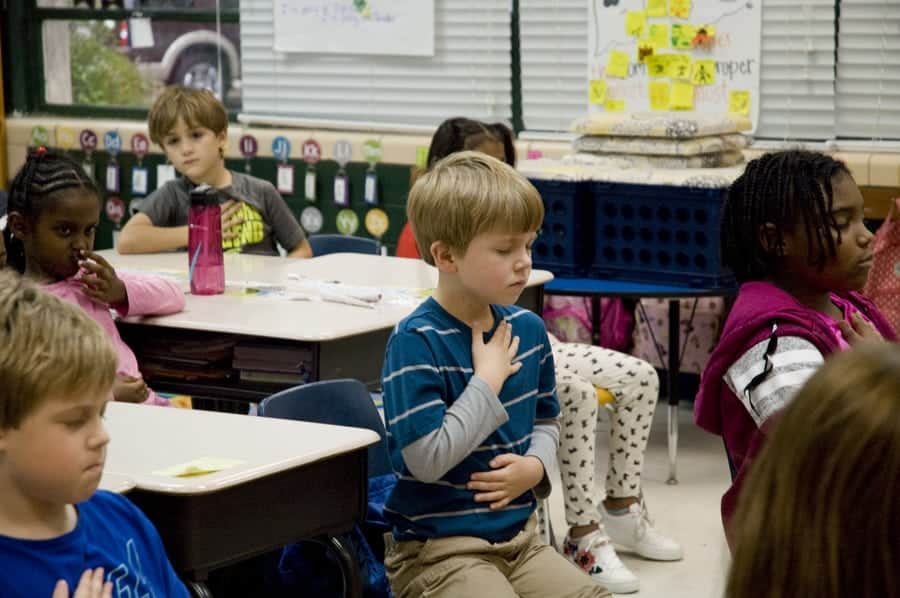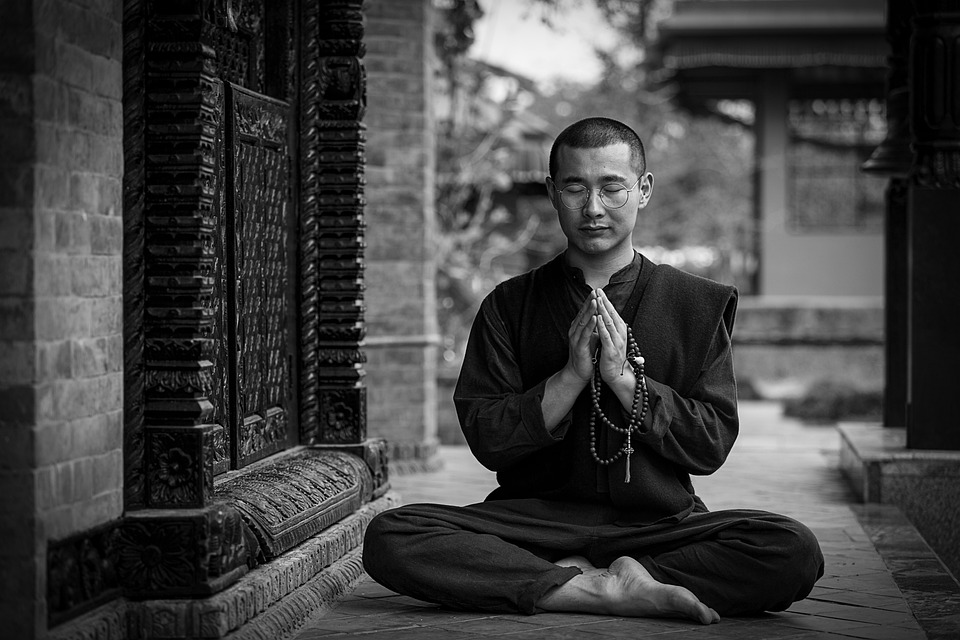What is yoga and how can it be (effectively) taught to children?

More and more schools are now introducting projects for teaching yoga to children and your school might be one of those.
In this article, I would like to point out what does it mean to effectively teach yoga to children within a public or private didactic context.
What I will tell you know about the science of yoga and how to pass it down to your students might have a great impact on the quality of your way of teachings and on the behaviours of your students. I therefore ask you to pay attention and to proceed step by step.
Why are schools gaining interest in teaching yoga to children?
I have been working as a yoga teacher for more than 10 years and as an instructor for primary school teachers for 6 years and I really saw lots of kids’ yoga projects coming to life.

The main reasons for this choice are often linked to the teachers’ need to find new educational stategies to manage the serious problems of education, such as:
- hyperactivity
- specific learning disorders
- maladaptive behaviours
- classrooms which are difficult to be managed
MIUR’s statistics state that specific learning disorders are constantly growing: this brings about the fact that we must adapt educational method to the problems and the unconveniences that the new generations are experiencing. What can we do about it?
Many teachers after having been deluded by refresher courses which are often too much theory and not enough practice have turned to kids’ yoga in order to find exercises that could keep children calmer and more focused during classes.
Having said this, if you also wish to teach Yoga, you need to hear what follows. According to my opinion as a yoga teacher, in order for the yoga exercises to be of real help with your classes, they need to become part of a structured program that guarantees you following middle-long term foundamental goals:
- Improve the consciousness level of children;
- Improve the concentration and listening level during classes;
- Improve self-discipline;
- Improve relaxation and stress management skills.
Furthermore, it is important that the Yoga program is integrated into the rhytm of your teaching style and that is effectively helps you save time reducing rebukes, punishments while increasing the learning skills of your students.
It’s a cost-benefit analysis: the cost of Yoga as far as time, effort and study is concerned, must be repayed with the same amounts of visible benefits in the didactics.
Remember: the time you invest in Yoga should at least improve the attention skills of your students. If this is not the case, it means that you should reconsider your yoga program.
Be careful: if you don’t have a well structured yoga program, you run the risk of wasting time uselessy, which might also affect your didactics.
How is yoga taught in schools in Italy?
In Italy Yoga is taught mostly by an external professional who proposes cooperation games, concentration exercises, balance games, meditation, mindfullness and breathing exercises, yoga postures but also mandala creation and mantra chanting.

Just take a moment to ask yourself:
Do these activities really have the power to improve awareness, concentration, self-discipline and relaxation in children?
In this case, the question with the external professionals does not concern the efficiency of the proposed exercises (on which there’s no doubt), but the mode in which the activities are proposed.
According to my experience, when Yoga classes happen once per week, they do not produce visible long-term results and they don’t help teachers improve their teaching style.
Therefore, if you intend to propose yoga to your students on a weekly basis, is it surely better than nothing, just don’t expect immediate changes.
Apart from that, depending on an external professional does not help the freedom and autonomy of the teacher that instead plays an extremely important role in this Yoga in Classe Teacher Training School.
I’ll give you a real example. In a well-known school complex Yoga has been taught by an external yoga teacher for 4 years.
Classes were organized into bundles of 10 sessions, 1 hour per week.
But as soon as the teacher went away, unfortunately children and teachers forgot everything about it.
And this is not all about it. This is what we noticed: during Yoga classes children could stay “calm and relaxed” for a while, but after a couple of hours the magic effect vanished and the teachers were back at the start.
Yoga done this way will never ahve a real educational effect.

According to my experience, I noticed that Yoga becomes more effective if proposed directly from the teacher of the classroom throught the magic formula “10 minutes every day“.
For this reason, if you are a primary school teacher, you are the most suitable person to teach the science of Yoga to tour students, since you are the one that spends most time with them.
Furthermore, who better that you knows the strenghts and weaknesses of the children? Thanks to your sensitivity and your practical experience with them you will be able to select the best Yoga exercises that will have the most effect on the classroom.
This is exactly the formula of our Yoga in Classe Course: after the training you will know exactly what works and what doesn’t work with your students.
Remember: thanks to just 10-minute Yoga a day you can change the energy in the classroom and you can lead your students to be even more calmer and relaxed during lesson. You just need to learn the access key and the right tools.
What are the origins of Yoga? How can it be integrated into the didactics?

Let us now dive deeply into the world of Yoga. Let’s start by saying that Yoga is not a “religion” thwithout deepening the philosophical aspect.
So that, if yoga is no religion, what is it?
Let’s take a step back to the origins: please follow me. Since ancient times, Yoga has been used by the sages as a tool for the inner reseach directed to find out the eternal lows of Nature: from this point of view, Yoga looks more like a science that studies the interior microcosm.
Those Sages were researching the law of Nature in order to find out (as we all desire) the secret to permanent happiness and the way to trascend suffering.
Later those laws have been condensated in the 2 most authoritative texts of Yoga (that I suggest you to read) which are the Bhagavadgītā and the Yoga Sutra by Patanjali.
The Teacher Training Course “Yoga in Classe” grounds its theorethical bases on these 2 books, which serve as a beacon for anyone who wants to approach this discipline in a serious way.
Bhagavadgītā and Yoga sutra might be your starting point to create a lot of “educational exercises for children” (I just revealed one of my secrets…).
Let me give you an example. The Yoga Sutra describes in a strict and scientific way the 8 phases (Astanga) that a researches should go through in order to reach a perfect state of balance and wellbeing (Samadhi), let’s have a look at them:
- Yama (5 rules for a good behaviours towards others)
- Nyama (5 rules that improve one self)
- Asana (Correct postures)
- Pranayama (Controlling the vital energy through breathing exercises)
- Pratayhara (Withdrawal of the senses)
- Dharana (Perfect concentration)
- Dyana (Contemplation)
- Samadhi (We can define it with a state of perfect wellbeing and unity)
While the first 4 phases can be directly controlled by our behaviours and by practicing specific exercises, the other phases follow as a natural consequence: it’s just like the flower that can only use its beauty and fragrance in order to attract the bee.
Given these 8 steps, we can extrapolate the ultimate goal of children’s yoga: we aim at integrating the first 4 steps into the didactics, in order to obtain Pratayhara and Dharana, that is, the perfect ability of avoiding distraction and keep concentration on a task for a long time.
I wish to explain you even deeply in which way the first 6 parts of Ashtanga Yoga might be of help:
Yama and Nyama
The rules of conduct towards oneself and others improve the self-discipline and the ability to take responsability.
Thanks to those kind of exercises you can reduce the disfunctional behaviours of your students and let them be more balanced at an emotional level.
Asana
Mind and body are inseparable. If you allign the body of your students in a correct way, accordingly you will improve their intellective functions. In this sense, Yoga could be very useful to correct the sedentary attitude of the children.
Unfortunately, starting from the first years of the primary school some students learned to sit in a wrong way and with a unstraight back. But sitting upright is much more important than you thinks, since it deeply affects the ability to concentrate.
In the Yoga in Classe Teacher Training, in the first module called Five Steps, you will find the section “Posture OK”: a vademecum that will help you correct the posture of your students in a simple way, gaining more concentrated students.
Pranayama - Breathing exercises
It is very importand for you to know that mind and breath are extremely interconnected.
When a child is agitated her breath is short ans superficial, but if you ask her to take deep and long breath, she will relax in a few seconds.
In the practice of Yoga breathing exercises have a fundamental place in order to calm the mind and might be great “secret tools” to balance their mood swings.
With the constant breathing practice students will learn how to concentrate and manage stress, often even better that their teachers 🙂
Pratayhara - Sense withdrawal
Thanks to Pratayhara (withdrawal of the senses), you teach your students to distract less and be less subject to external influence.
Unfortunately, today children are overstimulated through TV, action movies, videogames, smartphone, internet. This brings them to get quickly tired of everything and to zap with reality, as well.
For this reason it is very important that you grand yourself a long-term program that aims at correcting the children by turning them more conscious about the importance and the beauty of prolonged concentration.
Dharana - Concentration
Dharana is the ability to concentrate in a permanent way. Normally after 10-15 minutes of frontal teaching you will have noticed that children do not follow you anymore.
But with the right adjustments and methods you can invert the curve of attention of your students and increase the time they can can keep their concentration on your class.
I called this technique “concentration at increasing levels“: we will go deeper into it in the second module which is dedicated to the integration of Yoga into the didactics.
What is the secret for a children's yoga program to be effective?
This is a great question! The Bhagavad Gita states that inside everyone of us theres’s an “interior teacher” that can guide us in our everyday life, in our growth and in the discovers of life: we have the choice to listen to it or not. In the Western world we call this guiding voice “intuition”, which is a little bit reductive with respect to the yogic concept of “Paramatman”.

Maria Montessori explains this concept very well in the book “The discovery of the child” where she tells of a divine sparks present inside every child and that lets him strive for perfection in everything he does.
Even the most difficult children have it and if you are able to activate it, with time the children will correct it by themselves. Making use of this incredible concept your Yoga program will be really effective.
In the Yoga in Classe Method, the Yoga exercises once they have been learnt by the children they are not imposed but you will invite them to choose the exercises according to how they feel.
Giving your students the chance to choose is a successful way to let them become more intuitive and more motivated in teh practice.
What is the first step for me?
If your are eager to teach yoga in your classroom, the first suggestion is not to improvise. If you improvise and the first classes don’t go well, your students will get a wrong first impression and it will not be easy to regain their trust. For this reason, if you want to propose something new to your students, I recommend you gain the necessary training in order to go without fail.
In the free introductive mini-course “Yoga in Classe: Attentive students in 10 minutes per day”, I will supply you from the beginning with an effective exercise to improve the concentration ability of your students.
I suggest you to propose this exercise at the beginning of each class in order to prepare the children to be attentive and to participate in the classes.
You can also use this exercise as a rescue plan to calm down the euphoric energies of your students.
Click the banner on the left and subscribe now.
See you soon, bye!
